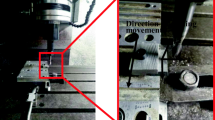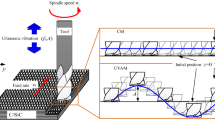Abstract
Carbon fiber-reinforced silicon carbide matrix (C/SiC) composites are typical difficult-to-cut materials due to high hardness and brittleness. Aiming at the problem of the serious high cutting force and poor surface quality in conventional milling (CM) C/SiC composite process, ultrasonic vibration-assisted milling (UVAM) and conventional milling tests with a diamond-coated milling cutter were conducted. The results showed that reducing the feed per tooth, cutting depth, or increasing the cutting speed can reduce the average cutting force, and increasing the ultrasonic amplitude, the average cutting force decreases first and then increases. With the assistance of ultrasonic vibration, the maximum reduction rates of average cutting forces Fx, Fy, and Fz were 43.7%, 29.16%, and 68.09%.The ultrasonic vibration assisting effect does not significantly improve the damage of materials such as fiber breakage during processing. The ultrasonic vibration assisting effect improves the quality of processing edges. It is found that reducing feed per tooth, cutting depth, or increasing cutting speed can reduce surface roughness and increasing the ultrasonic amplitude reduces the surface roughness first and then increases. On the whole, the surface roughness of C/SiC ultrasonic vibration milling is slightly smaller than that of conventional machining.














Similar content being viewed by others
References
Faraz A, Biermann D, Weinert K (2009) Cutting edge rounding: an innovative tool wear criterion in drilling CFRP composite laminates. Int J Mach Tool Manu 49(15):1185–1196
Bhosale SB, Pawade RS, Brahmankar PK (2014) Effect of process parameters on MRR, TWR and surface topography in ultrasonic machining of alumina–zirconia ceramic composite. Ceram Int 40(8):12831–12836
Karpat Y, Bahtiyar O, Değer B (2012) Mechanistic force modeling for milling of unidirectional carbon fiber reinforced polymer laminates. Int J Mach Tool Manu 56:79–93
Jahromi AS, Bahr B (2010) An analytical method for predicting cutting forces in orthogonal machining of unidirectional composites. Compos Sci Technol 70(16):2290–2297
Tsao CC (2008) Thrust force and delamination of core-saw drill during drilling of carbon fiber reinforced plastics (CFRP). Int J Adv Manuf Technol 37(1-2):23–28
Patil S, Joshi S, Tewari A et al (2013) Modelling and simulation of effect of ultrasonic vibrations on machining of Ti6Al4V. Ultrasonics 54(2):694–705
Muhammad R, Ahmed N, Demiral M, Roy A, Silberschmidt VV (2011) Computational study of ultrasonically-assisted turning of Ti alloys. Adv Mater Res 223:30–36
Henerichs M, Voss R, Fz K et al (2015) Machining of carbon fiber reinforced plastics: Influence of tool geometry and fiber orientation on the machining forces. CIRP J Manuf Sci Technol 9:136–145
Liu Q, Huang G, Xu X, Fang C, Cui C (2018) Influence of grinding fiber angles on grinding of the 2D−Cf/C−SiC composites. Ceram Int 44(11):12774–12782
Azmi AI, Lin RJT, Bhattacharyya D (2013) Machinability study of glass fibre-reinforced polymer composites during end milling. Int J Adv Manuf Technol 64(1-4):247–261
Eneyew ED, Ramulu M (2014) Experimental study of surface quality and damage when drilling unidirectional CFRP composites. J Mater Res Technol 3(4):354–362
El-Hofy MH, Soo SL, Aspinwall DK et al (2011) Factors affecting workpiece surface integrity in slotting of CFRP. Proc Eng 19(1):94–99
Altintas Y (2012) Manufacturing automation: metal cutting mechanics, machine tool vibrations, and CNC design[M]. Cambridge University Press, Cambridge
Wang H, Qin X, Wu D et al (2017) Optimization of cutting parameters in helical milling of carbon fiber reinforced polymer. Trans Tianjin Univ 24(15):1–10
Teimouri R, Amini S, Mohagheghian N (2017) Experimental study and empirical analysis on effect of ultrasonic vibration during rotary turning of aluminum 7075 aerospace alloy. J Manuf Process 26:1–12
Karpat, Bahtiyar O, Deger B (2012) Milling force modelling of multidirectional carbon fiber reinforced polymer laminates. Proc Cirp 1:460–465
Funding
This work is supported by the National Natural Science Foundation of China (grant no. 51375055)
Author information
Authors and Affiliations
Corresponding author
Additional information
Publisher’s note
Springer Nature remains neutral with regard to jurisdictional claims in published maps and institutional affiliations.
Rights and permissions
About this article
Cite this article
Yang, L., Zhibing, L., Xibin, W. et al. Experimental study on cutting force and surface quality in ultrasonic vibration-assisted milling of C/SiC composites. Int J Adv Manuf Technol 112, 2003–2014 (2021). https://doi.org/10.1007/s00170-020-06355-x
Received:
Accepted:
Published:
Issue Date:
DOI: https://doi.org/10.1007/s00170-020-06355-x




